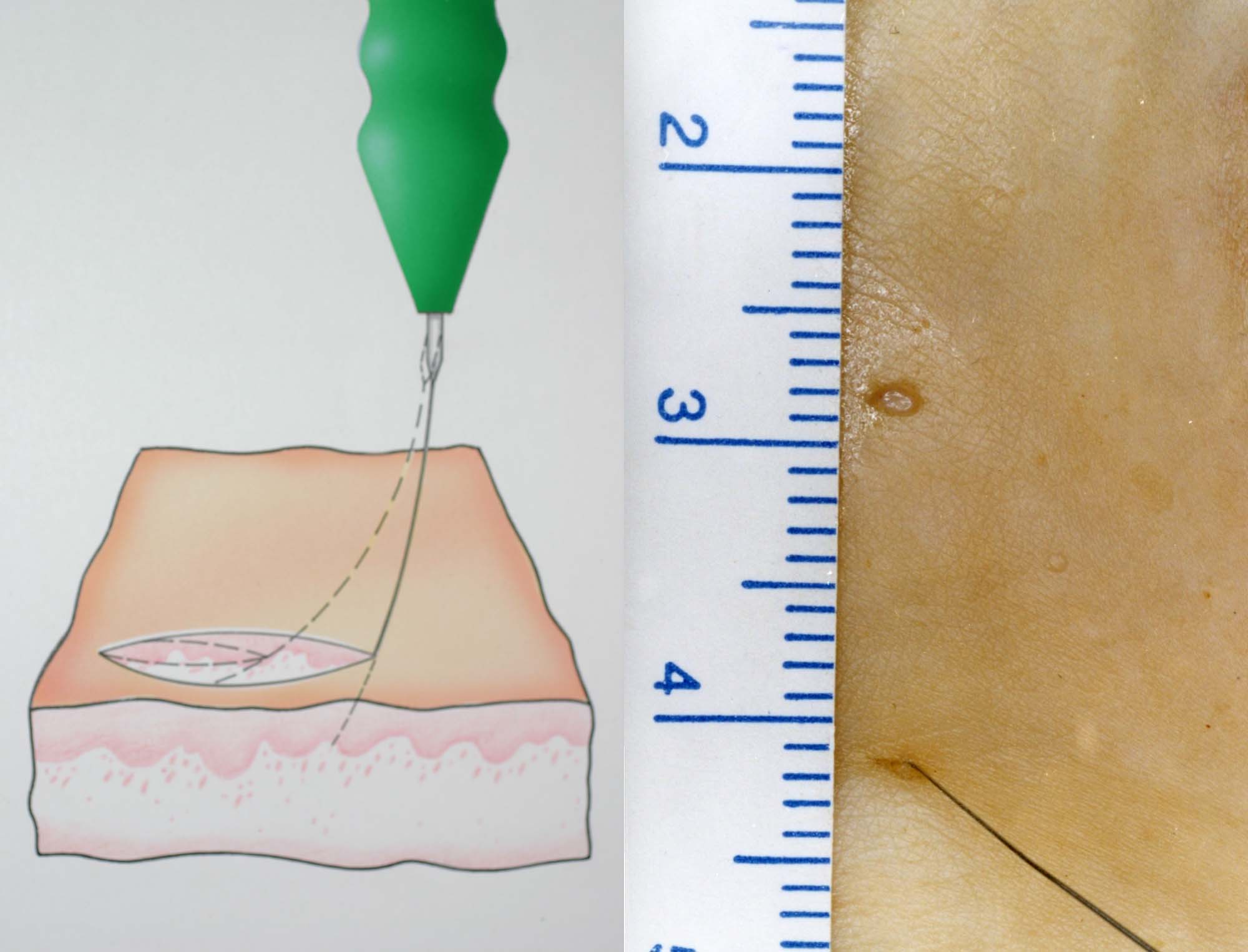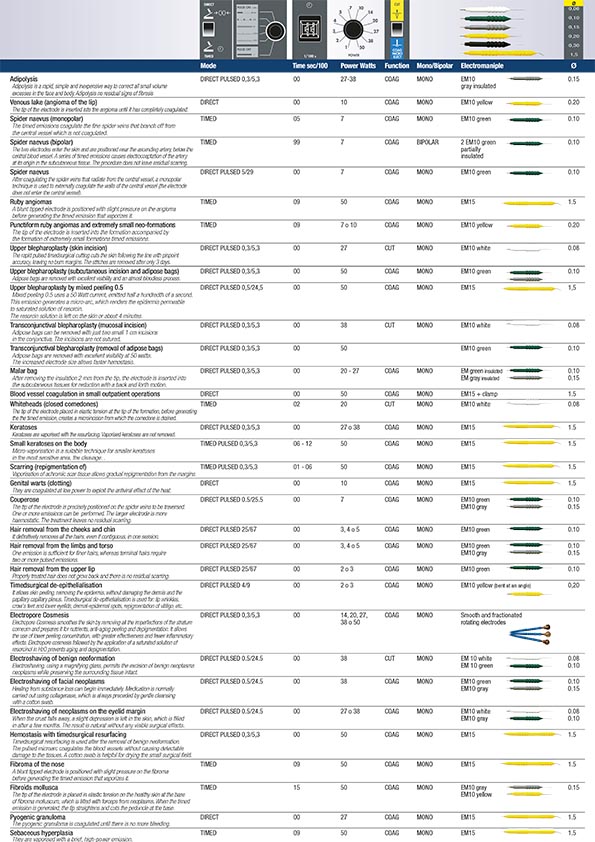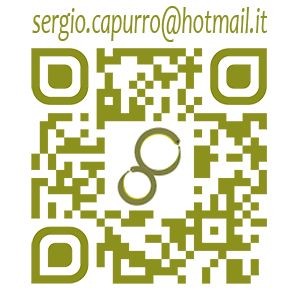Timedsurgery (Technique for the Implementation of Measured Electrosurgical Data) has transformed an empirical technique – electrosurgery – into a standardized method which enables us to perform operations that could not previously be undertaken. Today, Timedsurgery constitutes the most versatile and economical physical technique in surgical, dermatological and esthetic applications.
The technique involves precisely controlling the factors that condition a specific effect of a high-frequency current on the tissues. Specific currents for use in the various types of procedure are obtained by means of a power system specially designed to be programmable; the stable power is indicated in Watts and the duration of the emission is controlled. The currents are delivered by means of standardized active electrodes (EM 10 and EM 15 electromaniples), the fine tips of which (from 0.08 to 0.30) are indicated by means of a color code.
These parameters are perfectly reproducible, which means that the effects of a diathermal emission are highly predictable. The program data from a set of case records can therefore be gathered and utilized by other operators in similar cases. The program data and the operating techniques used in each specific operation make it easy to perform procedures that previously could only be undertaken by expert operators, if at all. Programmed diathermosurgery has been made possible by a technological innovation by Dr Capurro – the Timed apparatus (USA Patent); thanks to the programmable power system and controls of this apparatus, more than 70 clinical applications have become possible. Some of these are: the elimination of wrinkles from the lips and lower eyelids (mixed peeling with timedsurgical de-epithelialization), the reduction of drooping skin of the upper eyelids without incisions (blepharoplasty with 0.5 mixed peeling), the elimination of facial telangiectasias, the vaporization of small benign neoformations, the elimination of epidermal and dermo-epidermal blemishes, and the elimination of keratoses and xanthelasma. The Timed apparatus enables us to make incisions and micro-incisions without burning the edges; to remove benign neo-formations by means of electroshaving, which facilitates good spontaneous healing; to de-epithelialize the skin while maintaining the integrity of the dermal papillae and the capillary-papillary plexus; to render the skin smooth and permeable to the rejuvenating active principles of Electroporo Cosmesis; to reduce small excess volumes in the face and body by means of Adiopolysis; to re-pigment stable vitiligo or piebaldism by means of timedsurgical de-epithelialization, and much more…
 |
|
Rapid and slow pulsed timedsurgical cutting is one of the great innovations of this technique and enables incisions and micro-incisions to be made without burning the edges. |
Program Data
Manuals
- Timedsurgery Manual (English)
- Timedsurgery Manual (Français)
- Timedsurgery Manual (Deutsch)
- Timedsurgery Manual (Español)
Historical development of electrosurgery
Owing to its characteristics, surgical diathermy rapidly found many applications. It was used initially to destroy tumours, later for cutting and surgical haemostasis and subsequently for numerous dermatological and cosmetic operations.
In 1900, Riviere demonstrated that, at equal power, a greater lysive effect was produced with small electrodes, owing to the greater current density.
In 1907 de Keating - Hart and Pozzi coined the term fulguration (from Latin fulgor = lightning) to describe the superficial carbonisation caused by a spark between the electrode and the tissues.
In 1907 de Forest patented the triode vacuum tube and in 1908 he used a vacuum tube oscillator to produce the first diathermic cutting effect.
In 1909 Doyen used a low voltage, high-current, biterminal instrument to produce temperatures of 500-600°C, which were far higher than those previously obtained. In 1911 Clark differentiated electrocoagulation and fulguration.
Later, in 1924, Wyeth and Clark demonstrated the different effects of modulated and non-modulated high-frequency current on the tissue.
In 1926 Wyeth produced a generator capable of providing a cutting current and called the device “endothermic knife”. Much of the credit for the popularity of diathermosurgery is due to Bovie, who in 1928 described an instrument in which cutting and coagulation functions could be combined to control bleeding during electrosurgery.
In 1940, Greenwood produced an important accessory, the bipolar forceps. These forceps had blades which were electrically insulated from each other and were connected to both outputs of the diathermic generator. This technique of bipolar coagulation became indispensable in microand neurosurgery.
In 1958, Malis developed a bipolar diathermocautery with a floating patient circuit completely insulated from the electrical supply, thereby increasing the safety of the technique.
In 1970, spark-gap and vacuumvalve apparatus started to be replaced by more reliable and precise transistor-driven equipment and, by the end of that decade, the Timed apparatus had been developed (Capurro 1979).
In the middle of the 1990s, timedsurgery exploited medical scientific innovations to transfer knowledge from one operator to another in a methodical way, thus giving rise to timedsurgery, the most versatile operating system in the field of dermatological, plastic and aesthetic surgery.
Visit the Timedsurgery section in Medical Video Journal www.crpub.org ISSN 1971-8152







